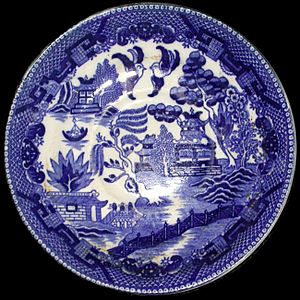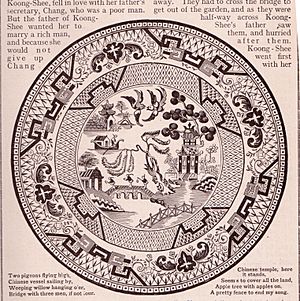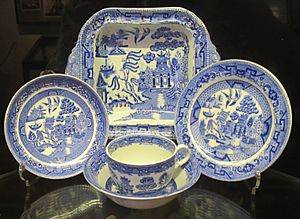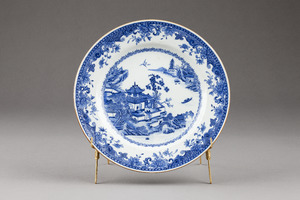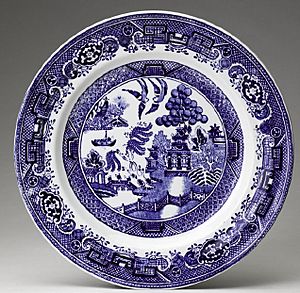Willow pattern facts for kids
The Willow pattern is a famous and detailed design found on ceramic dishes and plates. It became very popular in England in the late 1700s. English artists created this pattern by mixing ideas from beautiful blue-and-white dishes that came from China. This style is called chinoiserie, which means European art inspired by Chinese designs.
The Willow pattern was created when factories started making many dishes at once. They used a method called transfer printing. This was a way to print designs onto dishes instead of painting them by hand. This made it easier and faster to create many decorated plates.
Many Chinese-inspired designs were made this way. They appeared on fine bone china and on white earthenware dishes. The Willow pattern became the most popular and has been made ever since. It usually has a white background with a blue picture. But some factories used other colors. There are even older versions with hand-painted colors added to the printed outlines.
In the USA, people often call this design "Blue Willow."
Contents
What is the Willow Pattern?
It's not exactly clear when the Willow pattern was first made. In the 1780s, artists like Thomas Lucas and Thomas Minton were making Chinese-style pictures for pottery factories. These pictures included willow trees, boats, buildings, and birds. These elements were later used in the complete Willow pattern.
It's believed that the English Willow pattern was first created for Josiah Spode around 1790. This is because it includes special features from older Chinese designs that Spode's factory already used.
Key Features of the Design
The Willow pattern usually appears inside a round or oval border. It shows a garden next to water on the right side. In the garden, there is a large two-story building. It has steps leading up to it and arched windows. The roof has fancy curling decorations. This building is surrounded by trees and bushes. Another building roof can be seen among the trees to the right. A smaller building is on the left, near the water.
A path goes through the garden to the front of the scene. A zig-zag fence crosses the front of the picture. On the left side, a large willow tree leans out over the water. From this tree, a bridge with three arches crosses to an island. On the island, there is a house with a tall arched doorway and a small tree. Usually, three people are walking away from the garden on the bridge.
Beyond the bridge, the water is open and white. A boat is in the middle-left, with two small cabins. A person is pushing the boat with a long pole. In the upper left, there is a distant island with more buildings and trees. Above the whole scene, in the center, are two flying swallows. They are flying close to each other.
The English Willow pattern is known for including the bridge, the garden fence, the two birds, and the specific details of the buildings and trees, all arranged in this special way.
The Willow Pattern Story
To help sell the Willow pattern, different stories were made up about the pictures on the plates. The most famous story is told below. This story is like old Chinese and Japanese fairy tales about lovers who are separated. The English story about the plates first appeared in a magazine called The Family Friend in 1849.
A Romantic Fable
Once, there was a rich official called a Mandarin. He had a beautiful daughter named Koong-se. She fell in love with her father's humble helper, Chang. Her father was very angry because they were from different social classes. He fired Chang and built a tall fence around his house to keep the lovers apart.
The Mandarin planned for his daughter to marry a powerful Duke. The Duke arrived by boat to claim his bride. He brought a box of jewels as a gift. The wedding was set for the day the blossoms fell from the willow tree.
The night before the wedding, Chang dressed as a servant. He secretly entered the palace. The lovers escaped with the jewels. But the alarm was raised! They ran over a bridge, with the Mandarin chasing them. They finally escaped on the Duke's ship to a quiet island. They lived happily there for many years.
But one day, the Duke found out where they were. He sent soldiers to capture them. The soldiers caught the lovers and killed them. The gods felt sorry for them. They turned the lovers into a pair of doves. These doves are seen flying above the scene on the plates.
The Story's Impact
The Willow pattern story was made into a comic opera in 1901. It was called The Willow Pattern. It was also told in a silent film in 1914. The writer Robert van Gulik used some of the ideas in his detective novel The Willow Pattern. In 1992, Barry Purves made a short animated film about the story.
An Old Poem About the Pattern
People also made up poems to remember the details of the pattern. Here is one old poem:
- Two birds flying high,
- A Chinese vessel, sailing by.
- A bridge with three men, sometimes four,
- A willow tree, hanging o'er.
- A Chinese temple, there it stands,
- Built upon the river sands.
- An apple tree, with apples on,
- A crooked fence to end my song.
Another old poem from the late 1800s in Shropshire, England, goes like this:
"Two swallows flying high,
A little boat passing by,
A little bridge, with willows over,
Three men going to Dover,
Now Dover church stands very bare,
Twice a week they worship there,
A little tree with apples on,
And plaited palings in the sun"
Willow Pattern in Pop Culture

The Willow pattern has appeared in many movies and TV shows. It often helps to show a setting from the 1800s. It was seen in American western movies and TV shows. It also appeared in the comedy show The Munsters.
Blue Willow china is also featured in The Andy Griffith Show and Murder, She Wrote. In these shows, it suggests a simpler time or place. You can also spot it in the movies Funny Farm and Sleepy Hollow.
The story is told in the children's book The Willow Pattern Story by Allan Drummond.
Blue Willow by Doris Gates (1940) is a children's novel. It tells a realistic story about the Dust Bowl and Great Depression years. The blue willow plate in the story is a special gift. It belongs to Janey Larkin, a young girl whose family moves around for work. The plate comes to represent Janey's dream of having a permanent home.
The Willow pattern has also been used to advertise many different products and services over the years.


